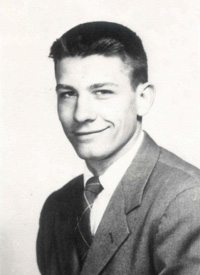Walter Norman Pahnke (1931-1971) was a minister, psychiatrist, and physician famous for designing the Good Friday Experiment, also known as the Marsh Chapel Experiment.
Pahnke received his Bachelor of Arts degree from Carleton College in 1952. He went on to earn his medical degree from Harvard University in 1956 and a Bachelor of Divinity from Harvard Divinity School in 1960. In 1964, he received his doctorate from the Harvard Graduate School of Arts and Sciences. Among his other educational accomplishments was training in LSD therapy and research with Hanscarl Leuner at the University of Göttingen in Germany. After this, Pahnke completed his residency at the Massachusetts Mental Health Care Center.
Pahnke was an assistant professor of psychiatry at the Johns Hopkins University School of Medicine when he died suddenly in a scuba diving accident in 1971. His research interests included the therapeutic uses, religious implications, and abuses of psychedelic drugs, the ethical and psychiatric issues in caring for dying patients, and the psychology of religion.
The designer of the Good Friday Experiment
The Good Friday Experiment was designed by Pahnke in 1962 to determine if psilocybin could elicit religious/spiritual experiences in theology students in a religious setting. Pahnke wrote his doctoral thesis on the results of the study under the auspices of his advisors Timothy Leary and Richard Alpert (Ram Dass) of the Harvard Psilocybin Project.1
In the double-blind experiment, Pahnke gave 10 theology students 10 mg of psilocybin during a Good Friday church service. Another 10 received niacin as an active placebo. Ninety percent of the students in the psilocybin group reported religious or mystical experiences while only 10% in the placebo group reported the same.
In 1991, Rick Doblin did a 25-year follow-up on the Good Friday Experiment for his undergraduate thesis work at the New College of Florida.2 Doblin’s analysis concluded that the mystical experiences the students had with psilocybin were in no way inferior to non-drug mystical experiences.
Roland Griffiths of Johns Hopkins University conducted a more rigorously controlled version of Pahnke’s study in 2002.3 Griffiths’ study had similar results to Pahnke’s, and he also did a 14-month follow up with the participants. After 14 months, over half of them rated their psilocybin experience as one of the top five most meaningful spiritual experiences they have had. They also said the experience with psilocybin increased their life satisfaction and personal well-being.
By 1967, Pahnke was working at the Maryland Psychiatric Research Center in Spring Grove, Maryland. He used LSD and DPT (dipropyltryptamine) as part of psychedelic therapy sessions with terminal cancer patients, people with severe neurosis, and alcoholics. He published several papers during this time including work using LSD in psychotherapy,4 with cancer patients,5 and for treating alcoholism.6 Pahnke also continued his research on the effects of psychedelics like LSD on religious/mystical experiences.7–9
More information on Walter Pahnke and his work is found on The Vaults of Erowid and in the William Richards Collection of Walter Pahnke Papers, 1952-1972 at Purdue University.

